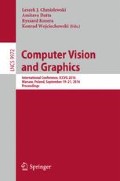Abstract
In this paper, an approach for the identification of people based on digital orthopantomogram images is proposed and experimentally investigated. This approach is composed of four main stages. In the first stage, the image quality is enhanced using the Laplacian pyramid. In the second stage, the image is segmented into individual sub-images, each containing a single tooth. To do this, the line that separates the upper and lower jaw is obtained using integral projections, and then information about the intensity and location of particular types of tooth is applied. The extraction of the shapes of the teeth is the third stage. This stage also later involves each particular shape being represented using the Point Distance Histogram algorithm to obtain its description. Finally, the resultant descriptions are matched with the objects stored in a template base for a person and, using these, biometric identification is performed.
Access this chapter
Tax calculation will be finalised at checkout
Purchases are for personal use only
References
Bowers, M.C.: Forensic Dental Evidence. Elsevier, Boston (2004)
Lee, S., et al.: The diversity of dental patterns in Orthopantomography and its significance in human identification. J. Forensic Sci. 49(4), 784–786 (2004)
Nassar, D., Ammar, H.H.: A prototype automated dental identification system (ADIS). In: Proceedings of the 2003 Annual National Conference on Digital Government Research, pp. 1–4 (2003)
Abdel-Mottaleb, M., et al.: Challenges of developing an automated dental identification system. In: IEEE Mid-west Symposium for Circuits and Systems, Cairo, Egypt, pp. 411–414 (2003)
Fahmy, G., et al.: Towards an automated dental identification system (ADIS). In: Zhang, D., Jain, A.K. (eds.) ICBA 2004. LNCS, vol. 3072, pp. 789–796. Springer, Heidelberg (2004). doi:10.1007/978-3-540-25948-0_107
Lu, J., Healy Jr., D.M.: Contrast enhancement of medical images using multiscale edge representation. In: Proceedings of SPIE: Wavelet applications, Orlando, 5–8 April 1994
Dippel, S., Stahl, M., Wiemker, R., Blaffert, T.: Multiscale contrast ehnahncement for radiographies: laplacian pyramid versus fast wavelet transform. IEEE Trans. Med. Imaging 21(4), 343–353 (2002)
Zhou, J., Abdel-Mottaleb, M.: A content-based system for human identification based on bitewing dental X-ray images. Pattern Recogn. 38(11), 2132–2142 (2005)
Frejlichowski, D., Wanat, R.: Application of the laplacian pyramid decomposition to the enhancement of digital dental radiographic images for the automatic person identification. In: Campilho, A., Kamel, M. (eds.) ICIAR 2010. LNCS, vol. 6112, pp. 151–160. Springer, Heidelberg (2010). doi:10.1007/978-3-642-13775-4_16
Jain, A.K., Chen, H.: Matching of dental X-ray images for human identification. Pattern Recogn. 37(7), 1519–1532 (2004)
Frejlichowski, D., Wanat, R.: Automatic segmentation of digital orthopantomograms for forensic human identification. In: Maino, G., Foresti, G.L. (eds.) ICIAP 2011. LNCS, vol. 6979, pp. 294–302. Springer, Heidelberg (2011). doi:10.1007/978-3-642-24088-1_31
Chen, H., Jain, A.: Automatic forensic dental identification. In: Jain, A.K., Flynn, P., Ross, A.A. (eds.) Handbook of Biometrics, pp. 231–251. Springer, USA (2008)
Frejlichowski, D., Wanat, R.: Extraction of teeth shapes from orthopantomograms for forensic human identification. In: Real, P., Diaz-Pernil, D., Molina-Abril, H., Berciano, A., Kropatsch, W. (eds.) CAIP 2011. LNCS, vol. 6855, pp. 65–72. Springer, Heidelberg (2011). doi:10.1007/978-3-642-23678-5_6
Burt, P.J., Adelson, E.H.: The laplacian pyramid as a compact image code. IEEE Trans. Commun. 31(4), 532–540 (1983)
Vuylsteke, P., Schoeters, E.: Image processing in computed radiography. In: Proceedings of International Symposium on Computerized Tomography for Industrial Applications and Image Processing in Radiology, Berlin, Germany, 15–17 March 1999
Stahl, M., Aach, T., Buzug, T.M., Dippel, S., Neitzel, U.: Noise-resistant weak-structure enhancement for digital radiography. SPIE 1999(3661), 1406–1417 (1999)
Frejlichowski, D.: The point distance histogram for analysis of erythrocyte shapes. Pol. J. Environ. Stud. 16(5B), 261–264 (2007)
Acknowledgements
The author of this paper wishes to thank gratefully MSc R. Wanat for his significant help in developing and exploring the described approach.
Author information
Authors and Affiliations
Corresponding author
Editor information
Editors and Affiliations
Rights and permissions
Copyright information
© 2016 Springer International Publishing AG
About this paper
Cite this paper
Frejlichowski, D. (2016). Application of the Point Distance Histogram to the Automatic Identification of People by Means of Digital Dental Radiographic Images. In: Chmielewski, L., Datta, A., Kozera, R., Wojciechowski, K. (eds) Computer Vision and Graphics. ICCVG 2016. Lecture Notes in Computer Science(), vol 9972. Springer, Cham. https://doi.org/10.1007/978-3-319-46418-3_34
Download citation
DOI: https://doi.org/10.1007/978-3-319-46418-3_34
Published:
Publisher Name: Springer, Cham
Print ISBN: 978-3-319-46417-6
Online ISBN: 978-3-319-46418-3
eBook Packages: Computer ScienceComputer Science (R0)

